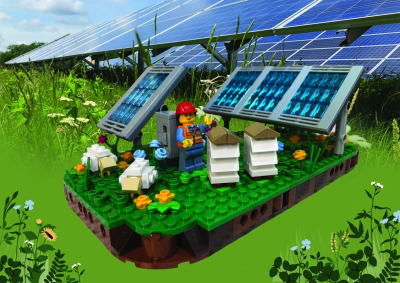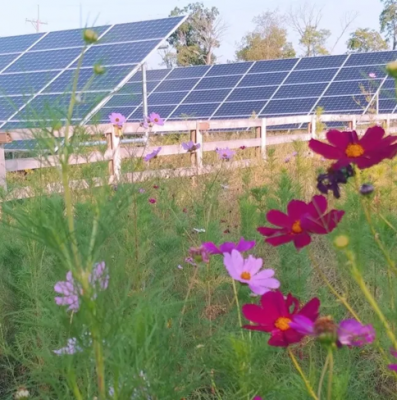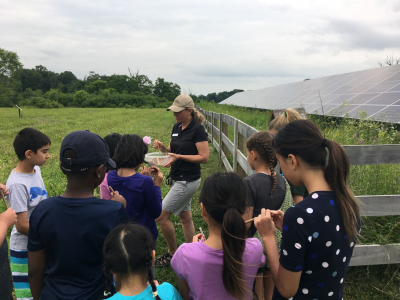In this explainer video, AgriSolar Clearinghouse Director Stacie Peterson offers up five things to know about agrisolar and pollinator habitat and beekeeping.
Tag Archive for: Pollinator Habitat
This article, written by AgriSolar Clearinghouse partners at Argonne National Lab and NREL, discusses the results of a five-year field study to understand how insect communities respond to newly established habitat on solar energy facilities in agricultural landscapes. Researchers found an increase in all habitat and biodiversity metrics, including a rise in abundance and diversity for both flowering plants and insects. Positive effects on the frequency of bee visitation to a nearby soybean field were also recorded. Their observations provide support for solar-pollinator habitat as a feasible conservation practice to safeguard biodiversity and increase food security in agricultural landscapes.
The push toward carbon-free and renewable energy sources has precipitated a nationwide (United States) trend to increase solar generation via ground-mounted photovoltaic (PV) arrays. Beyond carbon benefits, one possible way to provide additional ecological value of solar PV projects is to co-locate pollinator habitat when site conditions permit. Around 2015, the concept of a “scorecard” emerged that could assess the value of a solar project to pollinator species. The development and application of these scorecards, to date, has not been controlled by any central organization. Scorecards are being developed on a state-by-state basis using various processes, by a variety of subject matter experts, and using a range of oversight and review approaches. As such, there is variation between different state scorecard programs and divergent opinions regarding the scorecards themselves. Given that developing state and local laws and incentive programs are linked to the pollinator-friendly solar scorecards, it is important to consider the basis of the scorecards themselves. With interest in co-location of solar with pollinator habitat, this comprehensive study of existing pollinator solar scorecards considers the level of consistency across the scorecards, analyzes the specific scorable elements and their relative weighting, and investigates the factors that influenced scorecard development. A total of 15 state scorecards and one nonspecific scorecard available as of April 2021 were reviewed to identify common and differentiating features. A categorization system for individual scoring elements was created to facilitate numeric assessment across the available scorecards. Further, in order to understand the unique motivations and processes that influenced the design of the scorecards, interviews were conducted with 34 experts involved in scorecard design, policy development, and use, including university professors, state agency staff, and solar project developers, owners, and operators. Research uncovered a general lack of rigor, consistency, and oversight for scorecard design methodology, version control, and use. However, if the scorecards can be predictive of ecological outcomes – healthy pollinator habitat – then they may still be meeting their primary purpose. Field-based research is necessary to determine if there is a correlation between the points received on a pollinator-friendly scorecard and the actual solar PV site habitat conditions.
AgriSolar Clearinghouse partner Rob Davis has generously offered a full Solar Farm Lego set as a prize for the winner of the competition for best photo taken at one of the Follow the Sun tour field trips.
This set is priceless and can not be purchased. If you support the idea of a real-life Lego set being commercially available, vote here: LEGO IDEAS – Solar Farm. For a great background on the kit, see this NREL blog.
Please post your Follow the Sun photos to our forum here, or tag us on social media by using the hashtag #AgriSolar.

Solar Farm Lego Set. Photo: Rob Davis
The Follow the Sun Tour launched in Arizona, at Biosphere 2 and the Manzo Elementary agrivoltaic research site, and it was a great educational, inspirational, and networking event. Next up, we will travel to Minnesota on August 4 to tour Enel North America’s Lake Pulaski agrisolar site, US Solar’s Big Lake agrisolar site, and Connexus Energy’s agrisolar site in Ramsey. We’ll end the day on a sweet note with an Enel-sponsored Solar Farm to Table™ event featuring foods grown or pollinated at agrisolar sites. Get your free tickets here: Events – AgriSolar Clearinghouse.
The next week, we’ll travel to Massachusetts for a tour of the University of Massachusetts South Deerfield agrisolar research site and then the Million Little Sunbeams solar and hay farm, capping off the day at Knowlton Farms. Get your free tickets here: Events – AgriSolar Clearinghouse
In September, we will join forces with Jack’s Solar Garden, Sprout City Farms, and our partners at NREL and University of Arizona to tour Jack’s Solar Garden during its annual Night on the Farm. Stay tuned for details.
Over the next year, we’re planning more field trips to central California, Texas, Oregon, Virginia, Idaho, New York, and many more sites. If you have a site you’d like to highlight with an AgriSolar Clearinghouse fieldtrip, we’d love to hear from you. We’re looking forward to seeing you on the road!
In Warren County, Ohio, the Soil and Water Conservation District and the Park District collaborated to combine solar energy to power a park with pollinator habitat and an educational trail. The Solar Pollinator Habitat Discovery Trail was created to bring awareness to the public about clean energy and about the importance of pollinators to our food system.
Through a Power Purchase Agreement (PPA) with Rocknoll Energy Systems, a 275.6-kW solar array was installed and put into service in 2019. The system was designed to supply Armco Park with more than enough power to operate a pavilion, golf clubhouse, ball fields, and park shelters.

Photo: Warren County Soil and Water Conservation District
An Ohio Environmental Education Fund (OEEF) grant was awarded through the Ohio Environmental Protection Agency (OEPA) to develop the educational components of the project. This includes the Discovery Trail with seven interactive learning stations that highlight the science of pollinators and solar power. The station signage created by educators highlights the importance and natural behavior of pollinators and how individuals can create habitat for them. In addition, there are explanations of how solar panels work and the benefits of combining them with pollinator habitat.
The project also created an educational video series and a community involvement component. In the spring of 2021, community volunteers helped with the planting and watering of a native plant plot on the site. The site serves as a hub for the Conservation District and Park District to host in-person educational programs.

Photo: Warren County Soil and Water Conservation District
The trail’s creators hope it will help visitors take away knowledge about energy conservation and clean energy production, as well as how to help support pollinators through habitat development and protection.
This publication provides a pictorial guide to several of the most beneficial hedgerow plant species used in farmscaping for native pollinators and insect predators and parasites in California.
This Bee and Butterfly Habitat Fund guide outlines the steps that go into planning, preparing, planting, and maintaining pollinator habitat. This guide outlines best practices for achieving high-quality pollinator habitat through proper planning, preparing, maintaining and planting. The guide also covers what has happened to pollinator habitat in recent years and why it has declined, as well as covering why these methods and processes are especially crucial for establishing healthy bee populations on agrivoltaic sites.
This study addresses how land is being converted to accommodate for solar farms, and the potential for pollinator habitat to be established at solar farms in North Carolina. This report reveals that, based on previous land use, alternative vegetation selection, and cost comparison with current vegetation management techniques, the potential to create pollinator habitat at solar farms in North Carolina is likely to be feasible. The report covers suggested vegetation, estimated land-use acreage and cost analysis for agrivoltaic operations in North Carolina.
Starting in 2019, insect inventories were collected from a solar facility in Jackson County, Oregon as part of a study on plant-pollinator interactions in agrivoltaic systems. This study investigated the effects of solar arrays on plant composition, bloom timing and foraging behavior of pollinators in open fields, and in full shade and partial shade areas under solar panels in a predominant agricultural region of southern Oregon. The report shows that typically unused ground under solar panels can be used for pollinator habitat that benefits pollinating insects.
